云计算虚拟化术语大全
云计算专业术语
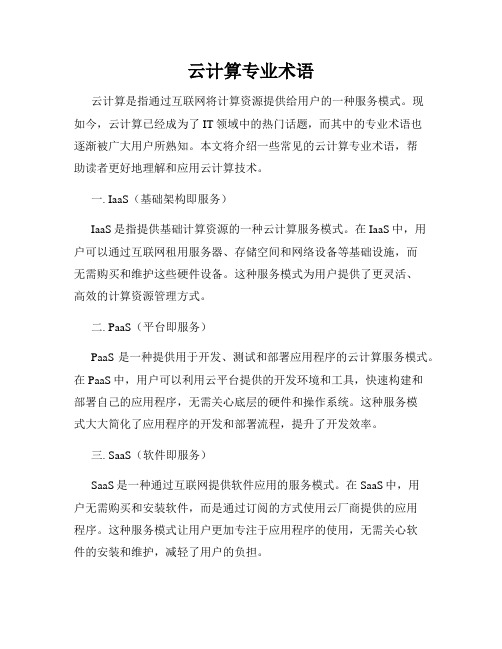
云计算专业术语云计算是指通过互联网将计算资源提供给用户的一种服务模式。
现如今,云计算已经成为了IT领域中的热门话题,而其中的专业术语也逐渐被广大用户所熟知。
本文将介绍一些常见的云计算专业术语,帮助读者更好地理解和应用云计算技术。
一. IaaS(基础架构即服务)IaaS是指提供基础计算资源的一种云计算服务模式。
在IaaS中,用户可以通过互联网租用服务器、存储空间和网络设备等基础设施,而无需购买和维护这些硬件设备。
这种服务模式为用户提供了更灵活、高效的计算资源管理方式。
二. PaaS(平台即服务)PaaS是一种提供用于开发、测试和部署应用程序的云计算服务模式。
在PaaS中,用户可以利用云平台提供的开发环境和工具,快速构建和部署自己的应用程序,无需关心底层的硬件和操作系统。
这种服务模式大大简化了应用程序的开发和部署流程,提升了开发效率。
三. SaaS(软件即服务)SaaS是一种通过互联网提供软件应用的服务模式。
在SaaS中,用户无需购买和安装软件,而是通过订阅的方式使用云厂商提供的应用程序。
这种服务模式让用户更加专注于应用程序的使用,无需关心软件的安装和维护,减轻了用户的负担。
四. 多租户(Multi-tenancy)多租户是指云计算系统中将多个用户的应用程序和数据隔离在相同的基础设施上运行的能力。
通过多租户技术,云厂商能够在同一台服务器上同时为多个用户提供服务,实现资源的共享和利用率的提高。
五. 弹性计算(Elastic Computing)弹性计算是指根据用户需求自动调整计算资源的能力。
云计算平台可以根据用户的需求动态调整计算资源的分配,以满足应用程序在不同工作负载下的需求。
这种弹性的特性使得企业能够根据实际需求灵活地扩展或缩减计算资源,提高了系统的可用性和性能。
六. 数据中心(Data Center)数据中心是云计算服务的核心基础设施之一。
数据中心是一种集成了计算、存储、网络和其他基础设施的物理或虚拟化环境,用于托管和管理云计算服务所需的各种硬件设备和软件系统。
云计算的基本概念和术语
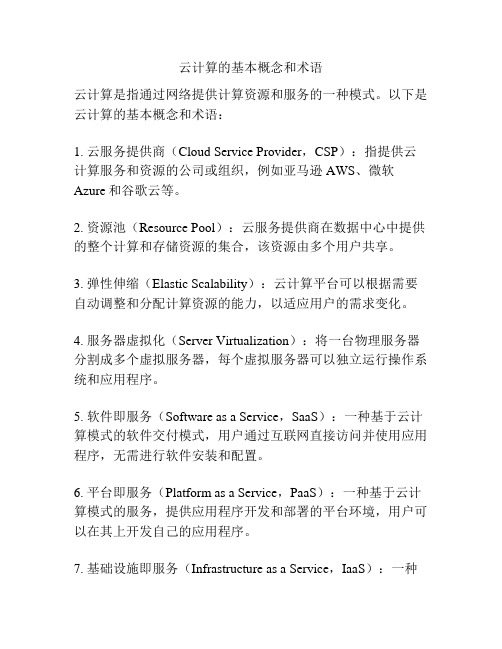
云计算的基本概念和术语云计算是指通过网络提供计算资源和服务的一种模式。
以下是云计算的基本概念和术语:1. 云服务提供商(Cloud Service Provider,CSP):指提供云计算服务和资源的公司或组织,例如亚马逊AWS、微软Azure和谷歌云等。
2. 资源池(Resource Pool):云服务提供商在数据中心中提供的整个计算和存储资源的集合,该资源由多个用户共享。
3. 弹性伸缩(Elastic Scalability):云计算平台可以根据需要自动调整和分配计算资源的能力,以适应用户的需求变化。
4. 服务器虚拟化(Server Virtualization):将一台物理服务器分割成多个虚拟服务器,每个虚拟服务器可以独立运行操作系统和应用程序。
5. 软件即服务(Software as a Service,SaaS):一种基于云计算模式的软件交付模式,用户通过互联网直接访问并使用应用程序,无需进行软件安装和配置。
6. 平台即服务(Platform as a Service,PaaS):一种基于云计算模式的服务,提供应用程序开发和部署的平台环境,用户可以在其上开发自己的应用程序。
7. 基础设施即服务(Infrastructure as a Service,IaaS):一种基于云计算模式的服务,提供虚拟化的计算资源和存储资源,用户可以灵活使用这些资源进行计算和存储。
8. 公有云(Public Cloud):云服务提供商通过公共网络向用户提供的云计算服务,用户可以按需购买和使用这些服务。
9. 私有云(Private Cloud):由组织或企业自己建立和管理的云计算环境,仅对内部用户提供服务。
10. 混合云(Hybrid Cloud):结合公有云和私有云的云计算环境,用户可以根据需要将应用程序和数据分布在公有云和私有云中。
11. 虚拟机(Virtual Machine,VM):一种在虚拟化环境中模拟的计算机系统,可以运行操作系统和应用程序。
云计算专业术语
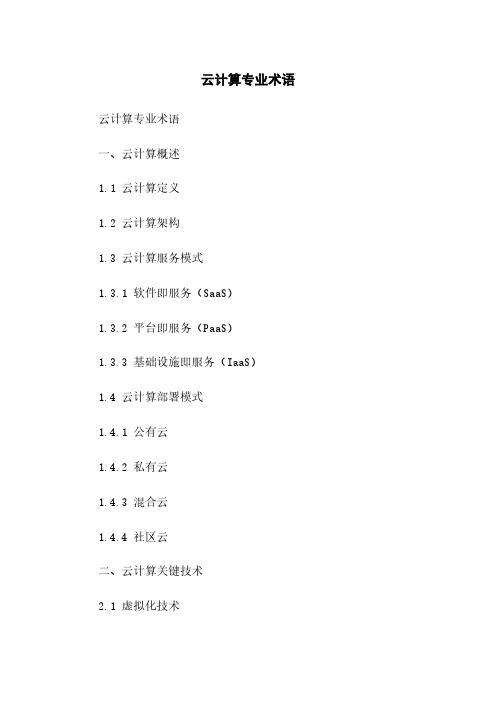
云计算专业术语云计算专业术语一、云计算概述1.1 云计算定义1.2 云计算架构1.3 云计算服务模式1.3.1 软件即服务(SaaS)1.3.2 平台即服务(PaaS)1.3.3 基础设施即服务(IaaS)1.4 云计算部署模式1.4.1 公有云1.4.2 私有云1.4.3 混合云1.4.4 社区云二、云计算关键技术2.1 虚拟化技术2.1.1 定义2.1.2 虚拟机技术2.1.3 容器技术2.2 分布式系统2.2.1 定义2.2.2 分布式存储2.2.3 分布式计算2.3 自动化管理技术2.3.1 定义2.3.2 自动化部署2.3.3 自动化扩展三、云计算服务产品3.1 云存储服务3.1.1 定义3.1.2 主流云存储服务商3.2 云计算虚拟机服务3.2.1 定义3.2.2 主流云计算虚拟机服务商3.3 容器云服务3.3.1 定义3.3.2 主流容器云服务商3.4 云数据库服务3.4.1 定义3.4.2 主流云数据库服务商3.5 云网络服务3.5.1 定义3.5.2 主流云网络服务商四、云计算安全与隐私4.1 数据安全4.1.1 数据加密4.1.2 访问控制4.2 用户隐私保护4.2.1 数据匿名化4.2.2 隐私政策4.3 安全威胁与防护4.3.1 网络攻击4.3.2 数据泄露防护五、云计算监控与管理5.1 云资源监控5.1.1 性能监控5.1.2 日志监控5.2 弹性伸缩管理5.2.1 自动扩容5.2.2 自动缩容5.3 故障恢复与备份5.3.1 备份策略5.3.2 灾难恢复附件:本文档涉及的附加信息。
法律名词及注释:1.虚拟化技术:将物理资源虚拟化为逻辑资源,实现资源利用的最大化和灵活性的增强。
2.分布式系统:由多个独立计算机节点共同组成的计算系统,节点之间通过网络进行通信和协作。
3.自动化管理技术:使用软件工具和算法来实现对云计算资源和服务的自动化管理和控制。
4.云存储服务:将数据存储在云计算提供商的存储设备上,并通过互联网进行访问和管理。
关于云计算的术语
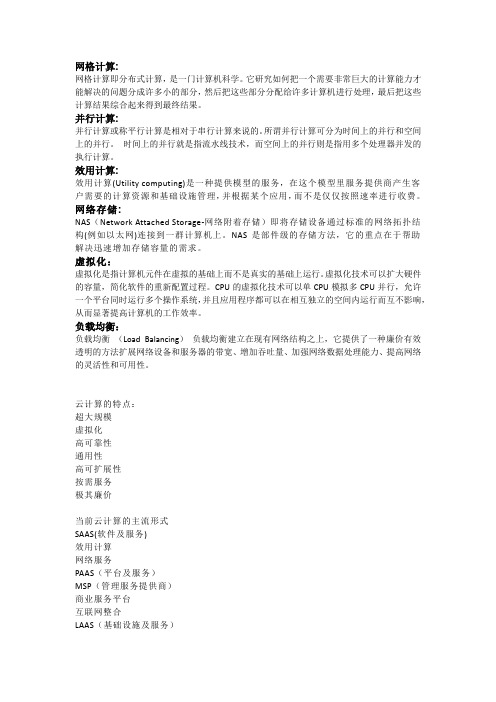
网格计算:网格计算即分布式计算,是一门计算机科学。
它研究如何把一个需要非常巨大的计算能力才能解决的问题分成许多小的部分,然后把这些部分分配给许多计算机进行处理,最后把这些计算结果综合起来得到最终结果。
并行计算:并行计算或称平行计算是相对于串行计算来说的。
所谓并行计算可分为时间上的并行和空间上的并行。
时间上的并行就是指流水线技术,而空间上的并行则是指用多个处理器并发的执行计算。
效用计算:效用计算(Utility computing)是一种提供模型的服务,在这个模型里服务提供商产生客户需要的计算资源和基础设施管理,并根据某个应用,而不是仅仅按照速率进行收费。
网络存储:NAS(Network Attached Storage-网络附着存储)即将存储设备通过标准的网络拓扑结构(例如以太网)连接到一群计算机上。
NAS是部件级的存储方法,它的重点在于帮助解决迅速增加存储容量的需求。
虚拟化:虚拟化是指计算机元件在虚拟的基础上而不是真实的基础上运行。
虚拟化技术可以扩大硬件的容量,简化软件的重新配置过程。
CPU的虚拟化技术可以单CPU模拟多CPU并行,允许一个平台同时运行多个操作系统,并且应用程序都可以在相互独立的空间内运行而互不影响,从而显著提高计算机的工作效率。
负载均衡:负载均衡(Load Balancing)负载均衡建立在现有网络结构之上,它提供了一种廉价有效透明的方法扩展网络设备和服务器的带宽、增加吞吐量、加强网络数据处理能力、提高网络的灵活性和可用性。
云计算的特点:超大规模虚拟化高可靠性通用性高可扩展性按需服务极其廉价当前云计算的主流形式SAAS(软件及服务)效用计算网络服务PAAS(平台及服务)MSP(管理服务提供商)商业服务平台互联网整合LAAS(基础设施及服务)。
云计算术语大全

云计算术语大全在云计算技术飞速发展的今天,了解和掌握相关的术语对于从业人员和普通用户都具有重要意义。
本文将为您带来云计算术语大全,帮助您更好地理解和应用云计算。
一、云计算的基本概念云计算(Cloud Computing)是指通过互联网将计算资源集中起来,按需付费使用,实现电脑存储和数据处理的方式,允许用户随时随地通过互联网访问和使用数据和应用程序。
1.云服务模型- 基础设施即服务(Infrastructure as a Service,IaaS):提供虚拟化的计算、存储和网络资源,用户可以自行管理操作系统、应用程序和数据的运行环境。
- 平台即服务(Platform as a Service,PaaS):在IaaS基础上,提供更高级别的开发环境,用户可以基于云平台进行应用程序的开发、测试和部署。
- 软件即服务(Software as a Service,SaaS):以云服务的形式提供应用程序,用户无需关心底层基础设施和平台,只需通过云平台进行应用程序的访问和使用。
2.云部署模型- 公有云(Public Cloud):基于云服务商提供的共享基础设施,面向公众用户提供服务,用户按需付费使用。
- 私有云(Private Cloud):基于机构或企业自己建设和管理的云平台,只对内部人员提供服务,用于满足特定的安全和合规性需求。
- 混合云(Hybrid Cloud):将公有云和私有云结合起来使用的部署模式,可以实现资源的灵活调配和扩展。
二、云计算相关术语1. 虚拟化(Virtualization):将物理资源(计算、存储、网络)进行抽象,通过软件技术将其划分为多个虚拟资源,实现资源的共享和隔离。
2. 弹性扩展(Elastic Scalability):根据实际需求,动态调整云计算资源的规模和容量,以适应业务的变化,提高资源利用率。
3. 自助服务(Self-Service):云计算用户可以根据自己的需求,自主选择和配置计算、存储和网络资源,实现自助式的服务使用。
云计算英语术语 文档
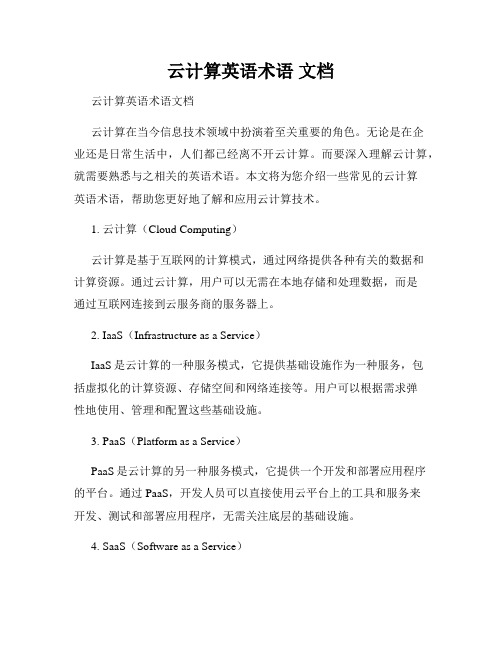
云计算英语术语文档云计算英语术语文档云计算在当今信息技术领域中扮演着至关重要的角色。
无论是在企业还是日常生活中,人们都已经离不开云计算。
而要深入理解云计算,就需要熟悉与之相关的英语术语。
本文将为您介绍一些常见的云计算英语术语,帮助您更好地了解和应用云计算技术。
1. 云计算(Cloud Computing)云计算是基于互联网的计算模式,通过网络提供各种有关的数据和计算资源。
通过云计算,用户可以无需在本地存储和处理数据,而是通过互联网连接到云服务商的服务器上。
2. IaaS(Infrastructure as a Service)IaaS是云计算的一种服务模式,它提供基础设施作为一种服务,包括虚拟化的计算资源、存储空间和网络连接等。
用户可以根据需求弹性地使用、管理和配置这些基础设施。
3. PaaS(Platform as a Service)PaaS是云计算的另一种服务模式,它提供一个开发和部署应用程序的平台。
通过PaaS,开发人员可以直接使用云平台上的工具和服务来开发、测试和部署应用程序,无需关注底层的基础设施。
4. SaaS(Software as a Service)SaaS是将软件以服务的方式提供给用户的一种云计算模式。
用户可以通过云服务访问和使用各种应用软件,而无需在本地安装和维护软件。
5. 虚拟化(Virtualization)虚拟化是一种将硬件资源划分为多个独立的虚拟环境的技术。
通过虚拟化,可以将一台物理服务器划分为多个虚拟服务器,从而提高硬件资源的利用率和灵活性。
6. 弹性伸缩(Elasticity)弹性伸缩是云计算的一个重要特性,指的是根据实际需求自动增加或减少计算资源。
通过弹性伸缩,可以根据负载的变化自动调整资源的使用量,以满足用户需求并降低成本。
7. 云存储(Cloud Storage)云存储是一种将数据存储在云服务商的服务器上的技术。
用户可以通过互联网将数据上传到云存储,以实现数据备份、共享和远程访问等功能。
信息技术专业术语大全

信息技术专业术语大全信息技术是当今社会中备受重视的领域,不仅在商业、科学、医疗等各个行业中得到广泛应用,而且也对我们的日常生活产生了深远影响。
在信息技术领域,有着许多专业术语,这些术语涵盖了各个方面的技术、概念和原理。
本文将会详细介绍信息技术领域中的2000个重要专业术语,希望能够为您提供一个全面而又系统的了解。
1. 人工智能(Artificial Intelligence, AI): 一种复制人类智能行为的技术,包括机器学习、语音识别、图像识别等。
2. 云计算(Cloud Computing): 一种通过互联网提供计算服务的模式,包括基础设施即服务(IaaS)、平台即服务(PaaS)和软件即服务(SaaS)。
3. 大数据(Big Data): 指数据量大、类型多样的数据集合,需要特殊的处理技术和工具。
4. 虚拟现实(Virtual Reality, VR): 一种通过计算机模拟的虚拟环境,用户可在其中进行互动体验。
5. 嵌入式系统(Embedded System): 一种特定用途的计算机系统,通常嵌入在其他设备中以完成特定的功能。
6. 物联网(Internet of Things, IoT): 通过互联网连接各种设备和物品,实现智能化和自动化控制。
7. 数据挖掘(Data Mining): 从大量数据中发现模式、趋势和关联性的过程。
8. 信息安全(Information Security): 保护信息系统免受未经授权的访问、使用、披露、破坏、修改、干扰或泄露的行为。
9. 前端开发(Front-end Development): 开发用户界面和用户体验的技术,包括HTML、CSS、JavaScript等。
10. 后端开发(Back-end Development): 开发应用程序后台和服务器端逻辑的技术,常涉及数据库和服务器端语言。
11. 数据库管理系统(Database Management System, DBMS): 一种管理和组织数据的软件系统,可实现数据的存储、检索和管理。
云计算中的虚拟化技术
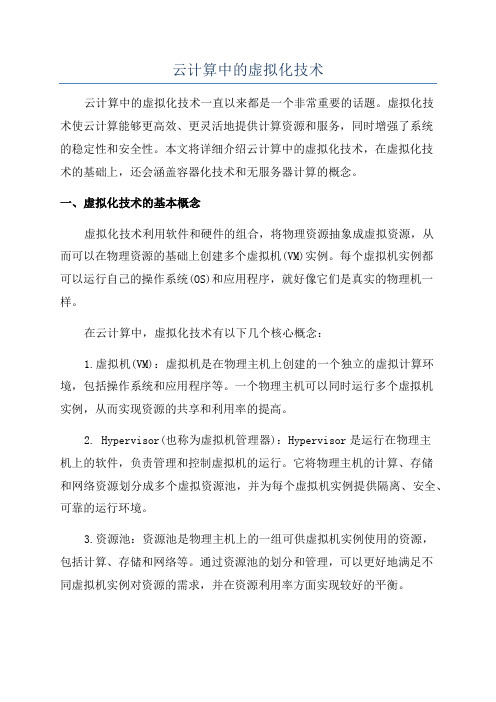
云计算中的虚拟化技术云计算中的虚拟化技术一直以来都是一个非常重要的话题。
虚拟化技术使云计算能够更高效、更灵活地提供计算资源和服务,同时增强了系统的稳定性和安全性。
本文将详细介绍云计算中的虚拟化技术,在虚拟化技术的基础上,还会涵盖容器化技术和无服务器计算的概念。
一、虚拟化技术的基本概念虚拟化技术利用软件和硬件的组合,将物理资源抽象成虚拟资源,从而可以在物理资源的基础上创建多个虚拟机(VM)实例。
每个虚拟机实例都可以运行自己的操作系统(OS)和应用程序,就好像它们是真实的物理机一样。
在云计算中,虚拟化技术有以下几个核心概念:1.虚拟机(VM):虚拟机是在物理主机上创建的一个独立的虚拟计算环境,包括操作系统和应用程序等。
一个物理主机可以同时运行多个虚拟机实例,从而实现资源的共享和利用率的提高。
2. Hypervisor(也称为虚拟机管理器):Hypervisor是运行在物理主机上的软件,负责管理和控制虚拟机的运行。
它将物理主机的计算、存储和网络资源划分成多个虚拟资源池,并为每个虚拟机实例提供隔离、安全、可靠的运行环境。
3.资源池:资源池是物理主机上的一组可供虚拟机实例使用的资源,包括计算、存储和网络等。
通过资源池的划分和管理,可以更好地满足不同虚拟机实例对资源的需求,并在资源利用率方面实现较好的平衡。
虚拟化技术的优势在于能够提高硬件资源的利用率、降低系统成本、提高系统的可靠性和可扩展性。
此外,虚拟化技术还可以实现对系统的快速部署和自动化管理,从而使系统更易于维护和扩展。
二、虚拟化技术的分类虚拟化技术在云计算中有多种实现方式,根据虚拟化的层次和对象的不同,可以将虚拟化技术分为以下几类:1. 服务器虚拟化:服务器虚拟化是最常见的虚拟化方式,它将物理服务器划分成多个虚拟机实例,并为每个虚拟机实例分配一定的计算、存储和网络资源。
常见的服务器虚拟化技术包括VMware、Xen和KVM等。
2.存储虚拟化:存储虚拟化将不同的存储设备组合在一起,并为虚拟机实例提供统一的存储接口。
云计算中的网络功能虚拟化(NFV)

云计算中的网络功能虚拟化(NFV)云计算已经成为了现代信息技术的重要组成部分,而网络功能虚拟化(Network Function Virtualization,简称NFV)则是云计算中的一个关键概念。
本文将介绍云计算中的NFV技术,探讨其在网络架构中的应用,以及其所带来的优势和挑战。
一、NFV的概念和背景网络功能虚拟化(NFV)是一种通过软件和虚拟化技术来实现网络功能的方法。
传统上,网络功能通常是通过物理设备来实现的,每一项网络功能都需要一个独立的物理设备进行支持。
然而,这种方式在硬件资源利用率、部署灵活性和管理维护的成本方面存在一些问题。
面对这些问题,网络业界提出了网络功能虚拟化的概念。
NFV通过将网络功能从硬件设备中解耦,将其转化为软件实体,并在通用服务器等硬件平台上进行部署,从而提供更灵活、高效的网络服务。
NFV 的发展得到了工业界和学术界的广泛关注和支持。
二、NFV的应用和优势1. 弹性和灵活性NFV的一个重要优势是它可以根据需求动态地进行资源分配和功能部署。
通过将网络功能虚拟化,网络服务提供商可以根据实时的流量负载等情况来灵活地调整网络功能的部署和开启。
这种弹性和灵活性大大提高了网络的可用性和性能。
2. 资源利用率提升传统的网络功能部署需要大量的专用硬件设备,而这些设备通常只能在一部分时间内得到充分利用,导致资源的浪费。
而通过虚拟化和共享硬件平台,NFV可以将不同网络功能集中在一台服务器上运行,从而实现资源的共享和最佳利用,提高资源利用率。
3. 管理和维护的简化传统的网络功能部署需要大量的物理设备和复杂的布线,这给网络的管理和维护带来了很大的挑战。
而通过NFV,所有的网络功能都可以通过软件来管理和配置,大大简化了网络的管理和维护工作,降低了成本和复杂度。
三、NFV的挑战和未来发展虽然NFV在提供弹性、灵活性和资源利用率方面有许多优势,但其也面临着一些挑战。
首先,虚拟化的网络功能可能会带来性能上的问题。
云计算英文术语

云计算术语(中英文对照)1. 自由计算free computing2. 弹性可伸缩elastic and scalable3. 主机host / instance4. 硬盘hard disk/ volume5. 密钥key6. 公开密钥public key7. 映像image / mapping8. 负载均衡load balancing9。
对象存储object storage10. 弹性计算elastic computing11. 按秒计费charged by seconds12. 多重实时副本multiple real—time copy13. 安全隔离security isolation14。
异地副本long—distance copy15。
后端系统back—end system16. 前端系统front—end system17. 写时拷贝技术copy—on—write technique18. 控制台console19. 监控台dashboard20。
远程终端remote terminal21。
服务端口service port22。
模拟主机simulation host display 显示器23. 路由器router24. 多路万兆光纤multiple 10000MB optical fiber25。
密码验证登录password authentication login26。
静态IP static IP27。
动态IP dynamic IP28. 混合云hybrid cloud29. SLA Service Level Agreement服务级别协议30。
分布式存储distributed storage31. 存储柜locker32. 云计算加速器cloud computing accelerator33. NIST National Institute of Standards and Technology 美国国家标准技术研究所34. 智能电网smart gird35。
云计算名词解释

云计算名词解释云计算(Cloud Computing)是一种基于互联网的计算方式,它通过将计算资源(包括硬件、软件和数据)通过网络交付给用户,在用户请求的时候按需提供服务。
具体来说,云计算将计算资源集中存储在多个数据中心中,并通过虚拟化技术将这些资源进行统一管理和分配,以便用户可以随时随地通过网络访问和使用这些资源。
以下是一些与云计算相关的常见名词解释:1. 云服务(Cloud Service):指通过互联网提供给用户的各种计算资源和应用服务。
云服务包括软件即服务(SaaS)、平台即服务(PaaS)和基础设施即服务(IaaS),用户可以根据需要选择使用不同的云服务。
2. 虚拟化(Virtualization):是将计算资源(硬件、操作系统、应用程序等)进行抽象和隔离的技术。
虚拟化可以将物理资源划分为多个逻辑资源,使得应用程序可以在逻辑资源上运行而无需关心底层的物理资源。
3. 弹性伸缩(Elastic Scalability):指根据用户需求自动扩展或缩小计算资源的能力。
云计算平台可以根据用户的请求自动增加或减少服务器或存储资源的数量,以保证应用程序的性能和可用性。
4. 云存储(Cloud Storage):是一种基于云计算的数据存储服务,用户可以将数据存储在云端而不是本地硬盘上。
云存储提供了高可用性、高扩展性和易于管理的优势,用户可以随时随地访问和管理存储的数据。
5. 云安全(Cloud Security):是保护云计算环境中数据和应用程序安全的一种技术和策略。
云安全涉及到数据加密、身份验证、访问控制和安全监控等方面,旨在防止数据泄露、恶意攻击和服务中断等安全威胁。
6. 云原生(Cloud Native):是一种基于云计算思维和技术架构的应用程序开发和部署方式。
云原生应用程序以微服务为基础,具有高度可伸缩、弹性可靠和快速部署的特点,能够更好地适应云计算环境的要求。
7. 云计算架构(Cloud Computing Architecture):是指云计算系统中各个组件和服务的组织结构和互相关系。
云计算专业术语范文
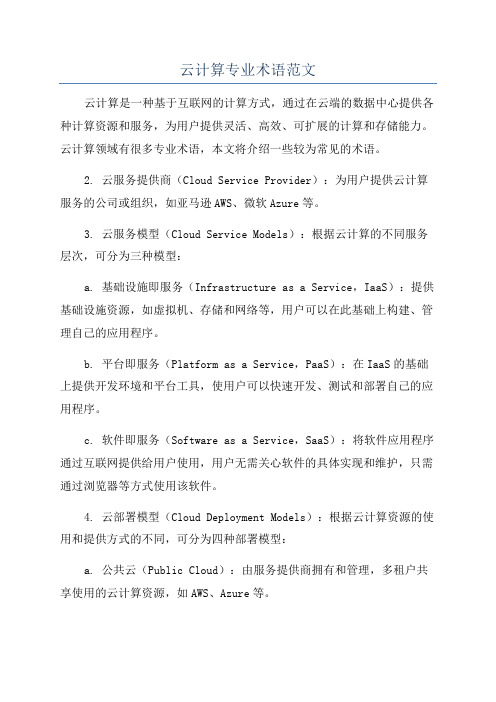
云计算专业术语范文云计算是一种基于互联网的计算方式,通过在云端的数据中心提供各种计算资源和服务,为用户提供灵活、高效、可扩展的计算和存储能力。
云计算领域有很多专业术语,本文将介绍一些较为常见的术语。
2. 云服务提供商(Cloud Service Provider):为用户提供云计算服务的公司或组织,如亚马逊AWS、微软Azure等。
3. 云服务模型(Cloud Service Models):根据云计算的不同服务层次,可分为三种模型:a. 基础设施即服务(Infrastructure as a Service,IaaS):提供基础设施资源,如虚拟机、存储和网络等,用户可以在此基础上构建、管理自己的应用程序。
b. 平台即服务(Platform as a Service,PaaS):在IaaS的基础上提供开发环境和平台工具,使用户可以快速开发、测试和部署自己的应用程序。
c. 软件即服务(Software as a Service,SaaS):将软件应用程序通过互联网提供给用户使用,用户无需关心软件的具体实现和维护,只需通过浏览器等方式使用该软件。
4. 云部署模型(Cloud Deployment Models):根据云计算资源的使用和提供方式的不同,可分为四种部署模型:a. 公共云(Public Cloud):由服务提供商拥有和管理,多租户共享使用的云计算资源,如AWS、Azure等。
b. 私有云(Private Cloud):由单一组织或企业拥有和管理,为其自身使用的云计算资源,通常部署在私有数据中心。
d. 混合云(Hybrid Cloud):将公共云和私有云相结合,形成一个统一且灵活的云计算环境。
5. 弹性计算(Elasticity):云计算具有可弹性调整资源的能力,根据用户的需求可以灵活增加或减少计算和存储资源。
6. 虚拟化(Virtualization):通过将物理资源抽象为虚拟资源,使得多个虚拟机共享底层物理资源,提高资源利用率和灵活性。
云计算术语大全

云计算术语大全云计算术语大全本文档旨在提供一个详尽的云计算术语大全,以帮助读者更好地理解云计算相关概念和术语的含义。
以下是各个章节的细化内容:1、云计算基础概念1.1 云计算云计算是一种通过互联网提供计算资源和服务的模式。
它可以通过按需提供的方式,快速分配和释放资源,并根据需求进行灵活扩展。
1.2 虚拟化虚拟化是将一台服务器或计算机资源划分为多个逻辑部分,使每个部分都能独立地运行不同的操作系统和应用程序。
1.3 弹性扩展弹性扩展是指根据需求自动调整云计算资源的数量,以适应业务的变化。
2、云计算模型2.1 公有云公有云是由第三方服务提供商提供给公众使用的云计算资源。
用户可以通过互联网访问并使用这些资源。
2.2 私有云私有云是由企业自行建立和管理的云计算资源,仅供企业内部使用。
2.3 混合云混合云是同时使用公有云和私有云的云计算环境。
公有云和私有云之间可以相互扩展和迁移。
3、云服务模式3.1 基础设施即服务(IaaS)IaaS是一种云计算服务模式,提供计算资源、存储和网络等基础设施,用户可以在这些基础设施上运行和管理自己的应用程序。
3.2 平台即服务(PaaS)PaaS是一种云计算服务模式,提供应用开发和部署的平台环境,开发者可以在平台上构建、测试和部署应用程序。
3.3 软件即服务(SaaS)SaaS是一种云计算服务模式,提供已经部署在云上的应用程序,用户可以通过互联网访问和使用这些应用程序。
4、云计算架构模式4.1 多租户架构多租户架构是一种云计算架构模式,多个用户共享相同的物理资源,但彼此之间的数据和应用程序是相互隔离的。
4.2 微服务架构微服务架构是一种云计算架构模式,将应用程序划分为多个独立的、可独立运行的服务,每个服务负责一个特定的业务功能。
4.3 容器化容器化是一种云计算架构模式,将应用程序及其所有依赖项打包到一个容器中,以确保应用程序在不同的环境中具有一致的运行方式。
5、云计算安全5.1 虚拟专用网络(VPN)VPN是一种通过公共互联网建立安全连接的方法。
云计算虚拟化技术的分类

云计算虚拟化技术的分类1.服务器虚拟化:服务器虚拟化是最常见的一种云计算虚拟化技术,通过将物理服务器分割成多个虚拟机,每个虚拟机可以运行独立的操作系统和应用程序。
虚拟机隔离运行,相互之间互不干扰,从而实现服务器资源的最大化利用。
2.存储虚拟化:存储虚拟化是通过对存储设备进行抽象化,将多个存储设备汇总到一个虚拟存储池中,然后按需分配给虚拟机。
这样可以实现存储资源的共享和灵活管理,提高存储性能和利用率。
3.网络虚拟化:网络虚拟化是将物理网络资源分割成多个逻辑网络,每个逻辑网络可以独立配置和管理。
虚拟网络可以根据需求进行动态调整和重新配置,实现灵活的网络连接和管理。
4.桌面虚拟化:桌面虚拟化是将用户的桌面环境虚拟化部署在云端,用户可以通过终端设备访问虚拟桌面。
这样可以实现用户的桌面环境集中管理和快速部署,减少终端设备的要求,提高终端设备的安全性和可靠性。
5.数据库虚拟化:数据库虚拟化是将多个数据库整合成一个统一的虚拟数据库,对外提供统一的访问接口。
用户可以通过虚拟数据库访问和管理分布在不同物理数据库上的数据。
这样可以简化数据库管理和维护,提高数据库利用率和性能。
6.应用程序虚拟化:应用程序虚拟化是将应用程序和相关的运行环境封装成一个独立的虚拟实例,用户可以通过云平台远程访问和运行这个虚拟实例。
这样可以提高应用程序的灵活性和可移植性,简化应用程序的部署和升级。
7.框架虚拟化:框架虚拟化是将应用程序的开发框架进行虚拟化,提供统一的开发环境和工具。
开发人员可以利用虚拟化框架快速构建和部署应用程序,提高开发效率和代码复用性。
虽然以上分类对云计算虚拟化进行了一定程度的分割,但实际上这些技术之间经常有交叉和融合。
在实际应用中,根据具体需求和场景,可以选择适合的虚拟化技术来实现资源的优化配置和利用。
云计算入门必备的90条术语

云计算入门必备的90条术语来源:云头条对云术语模糊不清?我们可以帮你厘清!Solutions Review网站从A到Z的云计算IT术语表对最流行的云计算术语逐一进行了定义。
A基于广告的定价模式――这种定价模式将服务低价或免费提供给客户,因广告连同服务提供给消费者,广告商补偿提供商。
亚马逊网络服务(AWS)――亚马逊网络服务是一套云计算服务,共同组成亚马逊网站提供的一个全面云平台。
AWS提供30多种云服务,涵盖IaaS、PaaS和SaaS这三大云计算模式,是最流行的云服务提供商,2015年占有全球云IaaS市场份额的近30%。
知名的AWS服务包括:Amazon EC2、Amazon Elastic Beanstalk和Amazon S3。
应用程序――应用程序是一群计算机程序,旨在让用户可以执行一组功能或任务。
应用编程接口(API)――应用编程接口(API)是一种接口,让用户可以访问来自另一个服务的信息,并将该服务整合到其自己的应用程序中。
通过一组定义的请求,发出请求的应用程序就可以访问被调用应用程序有限的部分功能。
API用于共享程序之间的有限功能。
API 的一个例子是该页面上的Facebook共享按钮,另一个例子是Yelp使用谷歌地图来显示附近餐馆。
相关阅读:基于 API 的 SaaS 正当道!Apache Hadoop――Apache软件基金会赞助的一个项目,请参阅Hadoop。
Azure――请参阅微软Azure。
B后端即服务(BaaS)――后端即服务(BaaS)或移动后端即服务(mBaaS)是一种云计算模式,提供商为Web和移动应用程序开发人员提供为应用程序创建云后端的工具和服务。
BaaS提供商通常使用自定义的SDK和API,让开发人员能够将其应用程序连接到后端云存储和众多功能,比如用户管理、推送通知以及与社交网络整合。
后端数据库――用户间接访问的任何数据库。
大数据――这个笼统的术语用来描述太庞大或太复杂,以至于无法使用传统的数据处理方法处理的非常规数据集。
云计算术语大全
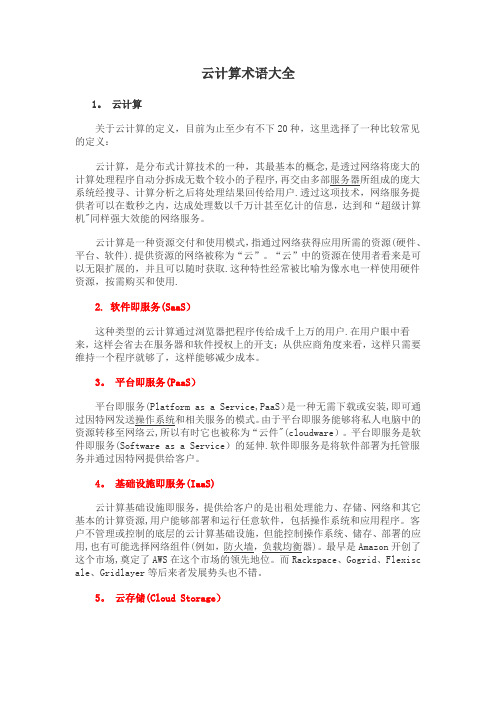
云计算术语大全1。
云计算关于云计算的定义,目前为止至少有不下20种,这里选择了一种比较常见的定义:云计算,是分布式计算技术的一种,其最基本的概念,是透过网络将庞大的计算处理程序自动分拆成无数个较小的子程序,再交由多部服务器所组成的庞大系统经搜寻、计算分析之后将处理结果回传给用户.透过这项技术,网络服务提供者可以在数秒之内,达成处理数以千万计甚至亿计的信息,达到和“超级计算机"同样强大效能的网络服务。
云计算是一种资源交付和使用模式,指通过网络获得应用所需的资源(硬件、平台、软件).提供资源的网络被称为“云”。
“云”中的资源在使用者看来是可以无限扩展的,并且可以随时获取.这种特性经常被比喻为像水电一样使用硬件资源,按需购买和使用.2. 软件即服务(SaaS)这种类型的云计算通过浏览器把程序传给成千上万的用户.在用户眼中看来,这样会省去在服务器和软件授权上的开支;从供应商角度来看,这样只需要维持一个程序就够了,这样能够减少成本。
3。
平台即服务(PaaS)平台即服务(Platform as a Service,PaaS)是一种无需下载或安装,即可通过因特网发送操作系统和相关服务的模式。
由于平台即服务能够将私人电脑中的资源转移至网络云,所以有时它也被称为“云件"(cloudware)。
平台即服务是软件即服务(Software as a Service)的延伸.软件即服务是将软件部署为托管服务并通过因特网提供给客户。
4。
基础设施即服务(IaaS)云计算基础设施即服务,提供给客户的是出租处理能力、存储、网络和其它基本的计算资源,用户能够部署和运行任意软件,包括操作系统和应用程序。
客户不管理或控制的底层的云计算基础设施,但能控制操作系统、储存、部署的应用,也有可能选择网络组件(例如,防火墙,负载均衡器)。
最早是Amazon开创了这个市场,奠定了AWS在这个市场的领先地位。
而Rackspace、Gogrid、Flexisc ale、Gridlayer等后来者发展势头也不错。
云计算中英文术语

云计算中英文术语云计算中英文术语1.云计算 (Cloud Computing)云计算是一种通过网络提供计算服务的模式,通过共享的虚拟化资源,按需提供计算能力、存储空间和应用程序。
用户可以通过互联网随时随地访问这些服务。
2.虚拟化 (Virtualization)虚拟化是将硬件资源抽象出来,通过逻辑层面的软件实现,使多个逻辑资源可以在同一物理硬件上并行运行。
虚拟化技术可以提高资源利用率和灵活性。
3.云服务 (Cloud Service)云服务是基于云计算模式下提供的各种计算和存储服务。
常见的云服务包括云服务器、云存储、数据库服务等。
4.弹性伸缩 (Elastic Scalability)弹性伸缩是指根据实际需求自动增加或减少计算资源。
云计算可以根据负载情况自动分配资源,从而提供扩展性和灵活性。
5.虚拟机 (Virtual Machine)虚拟机是在物理机上通过虚拟化技术创建的一台虚拟的计算机。
虚拟机可以独立运行操作系统和应用程序,提供资源隔离和灵活性。
6.容器 (Contner)容器是一种轻量级的虚拟化技术,可以在操作系统层面上将应用程序及其依赖项打包成一个独立的运行环境。
与虚拟机相比,容器更加轻便和快速。
7.存储服务 (Storage Service)存储服务是云计算提供的一种数据存储和管理服务。
用户可以通过云存储服务在云端存储和访问数据,享受高可用性和可扩展性。
8.数据中心 (Data Center)数据中心是集中存储、处理和分发数据的设施。
云计算的基础设施通常由大规模的数据中心构成,提供计算和存储资源。
9.负载均衡 (Load Balancing)负载均衡是将工作负载分配到多个服务器上,以实现资源的均衡利用和高可用性。
在云计算中,负载均衡可以根据负载情况调整资源分配。
10.高可用性 (High Avlability)高可用性是指系统能够持续提供服务,即使部分设备或服务出现故障,也能保持系统的正常运行。
云计算专业术语

云计算专业术语云计算专业术语:一、云计算基础概念1.云计算云计算是一种按需提供计算资源和服务的模式,通过互联网将计算能力、存储资源和应用程序等提供给用户,并允许用户根据需要进行动态扩展和缩减。
2.虚拟化虚拟化是一种将硬件资源进行抽象化、划分和整合的技术,可以将一台物理服务器划分为多个虚拟服务器,每个虚拟服务器可以独立运行不同的操作系统和应用程序。
3.弹性扩展弹性扩展是指根据用户需求自动调整云资源的数量,以适应流量峰值和低谷,提供更高的灵活性和可伸缩性。
4.虚拟机虚拟机是在物理主机上通过虚拟化技术创建的一个虚拟计算环境,可以运行独立的操作系统和应用程序。
二、云计算服务模型1.基础设施即服务(IaaS)基础设施即服务是提供虚拟化资源的一种云计算服务模型,用户可以通过API或控制面板管理虚拟机、存储和网络等基础设施资源。
2.平台即服务(PaaS)平台即服务是一种提供应用开发和运行环境的云计算服务模型,用户可以在提供的平台上开发、部署和运行自己的应用程序,无需关注底层的基础设施。
3.软件即服务(SaaS)软件即服务是一种提供应用程序的云计算服务模型,用户无需自行安装和维护软件,只需通过网络访问,即可使用提供的应用程序。
三、云计算部署模型1.公有云公有云是由云服务提供商建立和维护的云计算基础设施,多个用户共享该基础设施,并根据使用量进行付费。
2.私有云私有云是由单个组织或企业建立和维护的云计算基础设施,仅为内部用户提供服务,可以由组织自行搭建或由第三方提供。
3.混合云混合云是将公有云和私有云结合起来的一种部署模型,用户可以根据需求选择向公有云和私有云部署应用程序。
四、云计算相关技术1.负载均衡负载均衡是一种将网络请求平均分配到多个服务器上的技术,可以提高系统的可用性和性能。
2.自动化管理自动化管理是通过脚本和工具实现对云计算资源的自动化配置、部署、监控和维护等管理操作,提高运维效率。
3.容器化容器化是将应用程序及其依赖项打包成独立的容器,以实现应用程序的快速部署、可移植性和可伸缩性。
云计算的虚拟化技术
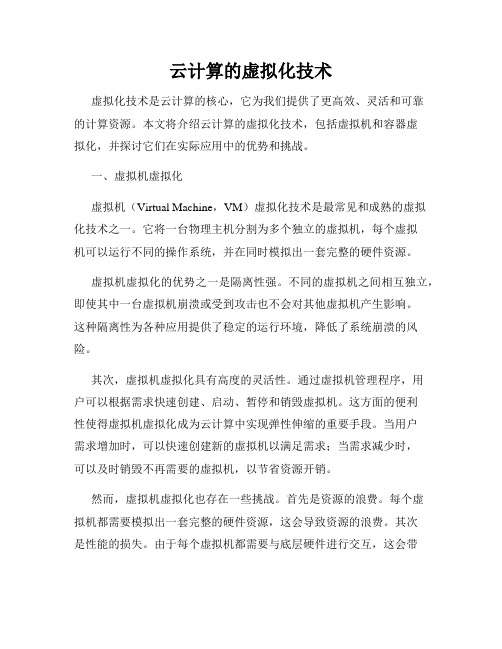
云计算的虚拟化技术虚拟化技术是云计算的核心,它为我们提供了更高效、灵活和可靠的计算资源。
本文将介绍云计算的虚拟化技术,包括虚拟机和容器虚拟化,并探讨它们在实际应用中的优势和挑战。
一、虚拟机虚拟化虚拟机(Virtual Machine,VM)虚拟化技术是最常见和成熟的虚拟化技术之一。
它将一台物理主机分割为多个独立的虚拟机,每个虚拟机可以运行不同的操作系统,并在同时模拟出一套完整的硬件资源。
虚拟机虚拟化的优势之一是隔离性强。
不同的虚拟机之间相互独立,即使其中一台虚拟机崩溃或受到攻击也不会对其他虚拟机产生影响。
这种隔离性为各种应用提供了稳定的运行环境,降低了系统崩溃的风险。
其次,虚拟机虚拟化具有高度的灵活性。
通过虚拟机管理程序,用户可以根据需求快速创建、启动、暂停和销毁虚拟机。
这方面的便利性使得虚拟机虚拟化成为云计算中实现弹性伸缩的重要手段。
当用户需求增加时,可以快速创建新的虚拟机以满足需求;当需求减少时,可以及时销毁不再需要的虚拟机,以节省资源开销。
然而,虚拟机虚拟化也存在一些挑战。
首先是资源的浪费。
每个虚拟机都需要模拟出一套完整的硬件资源,这会导致资源的浪费。
其次是性能的损失。
由于每个虚拟机都需要与底层硬件进行交互,这会带来一定的性能损失。
最后是部署和管理的复杂性。
虚拟机虚拟化需要进行操作系统的安装、更新和维护,这增加了管理的复杂性。
二、容器虚拟化容器虚拟化技术是相对虚拟机虚拟化的一种新形式,它通过操作系统的命名空间隔离和资源限制,实现了更为轻量级的虚拟化。
在容器虚拟化中,每个容器运行在相同的操作系统内核上,共享底层的操作系统和硬件资源。
容器虚拟化的优势之一是更高的性能。
由于容器共享操作系统内核和底层资源,与虚拟机相比,容器的启动时间更快,资源开销更小,可以更高效地利用硬件资源。
其次,容器虚拟化具有更高的可移植性。
容器打包了应用程序及其所有的依赖项,可以在不同的操作系统和环境中运行。
这使得应用程序的部署和迁移更加简单和灵活。
- 1、下载文档前请自行甄别文档内容的完整性,平台不提供额外的编辑、内容补充、找答案等附加服务。
- 2、"仅部分预览"的文档,不可在线预览部分如存在完整性等问题,可反馈申请退款(可完整预览的文档不适用该条件!)。
- 3、如文档侵犯您的权益,请联系客服反馈,我们会尽快为您处理(人工客服工作时间:9:00-18:30)。
当今时代,云计算技术日益发展,为了使更多用户清楚了解云计算,本文通过对现有的云计算资料进行梳理,列出了多条云计算相关的术语及其解释,以供学习参考。
1.-Cloud Computing1.1定义云计算(Cloud Computing),是一种基于互联网的计算方式【注:这个说法与wiki英文版的意思不一致,wiki英文版的原意是:“云计算”是以服务而非产品的形式交付“计算”,……】,通过这种方式,共享的软硬件资源和信息可以按需提供给计算机和其他设备。
整个运行方式很像电网。
云计算是继1980年代大型计算机到客户端-服务器的大转变之后的又一种巨变。
用户不再需要了解“云”中基础设施的细节,不必具有相应的专业知识,也无需直接进行控制。
云计算描述了一种基于互联网的新的IT服务增加、使用和交付模式,通常涉及通过互联网来提供动态易扩展而且经常是虚拟化的资源。
[2][3] 云其实是网络、互联网的一种比喻说法。
因为过去在图中往往用云来表示电信网,后来也用来表示互联网和底层基础设施的抽象。
典型的云计算提供商往往提供通用的网络业务应用,可以通过浏览器等软件或者其他Web服务来访问,而软件和数据都存储在服务器上。
云计算关键的要素,还包括个性化的用户体验。
云计算可以认为包括以下几个层次的服务:基础设施即服务(IaaS),平台即服务(PaaS)和软件即服务(SaaS)。
云计算服务通常提供通用的通过浏览器访问的在线商业应用,软件和数据可存储在数据中心。
(来源:/wiki/%E4%BA%91%E8%AE%A1%E7%AE%97维基百科中文版)1.2补充说明1.2.1一句话介绍:“云计算”是将“计算”作为服务而非产品通过网络向用户交付的方式。
1.2.2解析:【云】“云”这个字在这里作为一个修饰语使用,是对“网络”或“互联网”的比喻,虽然“云”也会被借用来描述在Intranet中甚至局域网中部署的某些信息系统,但除非说明,否则主要是指“互联网”。
“云”字在“云计算”中代表了交付“计算”的通路是“网络”,特别是指“互联网”。
计算任务并不依赖用户本地的软件和硬件实现,而是由“云端”某处的软件和硬件实现,本地的计算机连接到网络后,就可以接收或查看计算结果。
当“云”字与其他词组合成新词时,“云”并不能等同于“互联网”。
“互联网”作为一个修饰语时,倾向于指那些我们已经熟悉的互联网技术与服务——WWW网站、电子邮件、BBS等。
而“云”则倾向于更新的、更具有动态性的技术和服务,如:提供虚拟的服务器或服务器集群,提供在线使用的软件或软件开发平台等。
“云”字被单独使用时,是指能够提供某种以“云计算”方式提供服务的信息系统。
【计算】“计算”是指通过现代计算机系统完成的信息处理过程或效能。
“计算”需要有一定的硬件设备和系统软件及应用软件才能实现,因此“云计算”作为“计算”的一种交付形式,也相应分为不同的层次:基础设施即服务(IaaS)、平台即服务(PaaS)、软件即服务(SaaS)等。
【服务】“服务”相对于有形的“产品”,是指实现某种效用的过程,是无形的。
计算作为服务来提供的意义在于:a、用户可以不必为了达成某个信息处理任务,去处理自己并不擅长的信息技术相关事务,而专注于自己所需要的信息处理结果;b、用户可以根据信息处理任务的实际需求来分配资源,不必为那些不可预测的信息处理任务而事先超额投入资源,或受计算资源的限制降低业务灵活性。
1.3其他定义1.3.1维基百科英文版定义:Cloud computing is the delivery of as a rather than a , whereby shared resources, software, and information are provided to computers and other devices as a metered over a (typically the ).Cloud computing provides computation, software applications, data access, and storage resources without requiring cloud users to know the location and other details of the computing infrastructure.End users access cloud based through a or a light weight desktop or while the business and data are stored on at a remote location. Cloud application providers strive to give the same or better service and performance as if the softwareprograms were installed locally on end-user computers.At the foundation of cloud computing is the broader concept of infrastructure convergence (or ) and . This type of data centre environment allows enterprises to get their applications up and running faster, with easier manageability and less maintenance, and enables IT to more rapidly adjust IT resources (such as servers, storage, and networking) to meet fluctuating and unpredictable business demand。
(来源:维基百科英文版)1.3.2美国国家标准与技术研究院(NIST)定义:Cloud computing is a model for enabling convenient, on-demand network access to a shared pool of configurable computing resources (e.g., networks, servers, storage, applications, and services) that can be rapidly provisioned and released with minimal management effort or service provider interaction. This cloud model promotes availability and is composed of five essential characteristics (On-demand self-service, Broad network access, Resource pooling, Rapid elasticity, Measured Service); three service models (Cloud Software as a Service (SaaS), Cloud Platform as a Service (PaaS), Cloud Infrastructure as a Service (IaaS)); and, four deployment models (Private cloud, Community cloud, Public cloud, Hybrid cloud). Key enabling technologies include: (1) fast wide-area networks, (2) powerful, inexpensive server computers, and (3) high-performance virtualization for commodity hardware.The Cloud Computing model offers the promise of massivecost savings combined with increased IT agility. It is considered critical that government and industry begin adoption of this technology in response to difficult economic constraints. However, cloud computing technology challenges many traditional approaches to datacenter and enterprise application design and management. Cloud computing is currently being used; however, security, interoperability, and portability are cited as major barriers to broader adoption. (来源:/itl/cloud/index.cfm)2.软件即服务-SaaS2.1定义软件即服务-SaaS (Software-as-a-service 的简称),是随着互联网技术的发展和应用软件的成熟,而在 21 世纪开始兴起的一种完全创新的软件应用模式。
它与“on-demand software”(按需软件 ) , the application service provider(ASP ,应用服务提供商 ) ,hosted software( 托管软件 ) 所具有相似的含义。
它是一种通过 Internet 提供软件的模式,厂商将应用软件统一部署在自己的服务器上,客户可以根据自己实际需求,通过互联网向厂商定购所需的应用软件服务,按定购的服务多少和时间长短向厂商支付费用,并通过互联网获得厂商提供的服务。
用户不用再购买软件,而改用向提供商租用基于Web的软件,来管理企业经营活动,且无需对软件进行维护,服务提供商会全权管理和维护软件,软件厂商在向客户提供互联网应用的同时,也提供软件的离线操作和本地数据存储,让用户随时随地都可以使用其定购的软件和服务。
